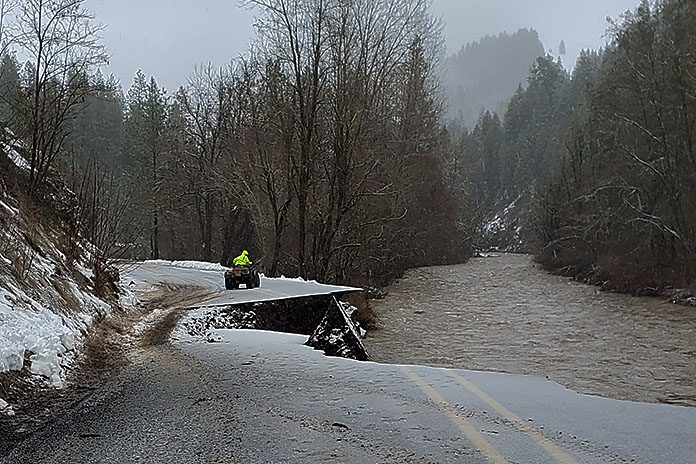
On Saturday, Feb. 8, the Umatilla County Sheriff’s Office reported there were successful evacuation efforts using two helicopters in areas affected by county flooding.
Helicopters provided by the National Guard and Umatilla County Search and Rescue personnel both worked on these missions.
A total of 16 people were evacuated from the Bingham Road area on Saturday. Five people were evacuated from the Mill Creek area. More evacuations are planned for Sunday.
On Friday, 26 people were evacuated by Umatilla County Search and Rescue. Most of the evacuated were from the Umatilla River Road/Bingham Road area and Mill Creek Road area.
Many roads in the county are still closed due to high water or damage. Bingham Road along the Umatilla River has been badly damaged from the flooding. Do not drive around road-closed signs as roads are impassable and you could interfere with ongoing rescue efforts.
As of Saturday afternoon, the following roads, in addition to Bingham Road, were closed:
Milton-Freewater:
- Mill Creek Road
- Walla Walla River Road closed at 15th Street Bridge to end of road at Harris Park
- Couse Creek Road—Walla Walla River east to Walla Walla River Road
- Spofford Road closed at intersection with Milton Cemetery Road south to Walla Walla River Road
- Cash Hollow Road at intersection with Kinnear
- Lincton Mountain Road at intersection with Walla Walla River Road
- County Road 525 from Powerline Road to North Fork Walla Walla River Road
Between Cayuse and Mission:
- River Road (Road #918) at N Cayuse Road
- White Road at intersection with River Road
- Thorn Hollow Grade at Duff Road
Additional Closures:
- Echo Meadows
- Stanfield Meadows
- Reith Road
- Thielson Road
People are asked to check www.tripcheck.com before they travel, although many county roads are not updated on this site. Do not drive through standing water and stay away from creeks, rivers and levees.
After waters recede, people will start working on after-flood recovery efforts. Here are some important things to remember during clean up:
- Take photos of your damage before you clean up, for insurance purposes
- National Flood Insurance Program (NFIP) policyholders who have questions about their flood insurance policy or the claims process, and disaster survivors who have general questions about the National Flood Insurance Program, can contact a NFIP representative by calling the NFIP Call Center toll-free at 1-800-427-4661 For individuals who are deaf, hard of hearing or have a speech disability, call 711 (TTY and other services are available). For VRS, please call 1-866-337-4262
- Check to make sure contractors doing repairs are licensed by visiting the Oregon Construction Contractors Board website
- Contact your city to find out where debris can be disposed of in your area; if you are a non-city resident, contact your county
- Resources for after-disaster cleanup can be found here in English and here in Spanish








